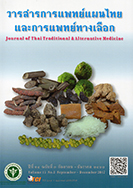Perception of Using Herbal Medicines in National List of Essential Medicines among Outpatients at Internal Medicine Department and Medical Doctors in Phatthalung Hospital
Main Article Content
Abstract
This study aimed to evaluate perception and factors associated with the use of herbal medicines in the National List of Essential Medicines (NLEM) among outpatients at the Internal Medicine Department and medical practitioners in Phatthalung Hospital. The study was conducted in 369 outpatients and 60 medical practitioners at the hospital. Data were collected using a questionnaire on the perception of using herbal medicines and then analyzed with descriptive statistics including simple regression analysis and multiple linear regressions to determine factors influencing the use of herbal medicines. The results indicated that, of all participating outpatients, 83.6% had ever used NLEM herbal medicines and 80.3% wanted to use herbal medicines, but only 67.4% actually received prescriptions for such herbal medicines. Both outpatients and medical practitioners showed a high level of knowledge (mean score 8.85 ± 1.69, 9.45 ± 1.03), attitudes (4.03 ± 0.63, 3.85 ± 0.58), acceptance (4.103 ± 0.60, 3.90 ± 0.56) and perception (4.15 ± 0.57, 3.99 ± 0.55) of using NLEM herbal medicines. The factors significantly associated with the perception of using herbal medicines were (1) acceptance in using, (2) acceptance in prescribing and (3) enabling and reinforcing factors (p < 0.01). The study showed high-level perception on using NLEM herbal medicines among outpatients at the Internal Medicine Department and medical practitioners in Phatthalung Hospital. Therefore, all are ready to support and promote the use of NLEM herbal medicines according to the national policy.
Article Details
References
2. Office of the National Economic and Social Development Board. The ninth National Economic and Social Development Plan B.E. 2545 – 2549 (A.D. 2002 – 2006). Bangkok: Office of the Prime Minister; 2002. 118 p.
3. Office of the National Economic and Social Development Board. The tenth National Economic and Social Development Plan B.E. 2550 – 2554 (A.D. 2007 – 2011). Bangkok: Office of the Prime Minister; 2007. 180 p.
4. Roekruangrit N. Factors influencing on use of herbal medicinal products in U-Thong Hospital, Suphanburi Province (thesis). Major in Health Promotion Management, Faculty of Public Health, Suphanburi: Thammasat University; 2010. 130 p. (in Thai)
5. Bloom, B.S. Taxonomy of education objective: The classification of education goals: Handbook 1 cognitive domain. 18th ed. New York: David Mckay; 1975. 175 p.
6. Srisaard B. Basic research. 9th ed. Bangkok: Suwiriyasarn; 2011. 219 p. (in Thai)
7. Best, J.W. and Kahn, V. J. Research in Education. 10th ed. United States of America: Pearson Education Inc; 2006. 384 p.
8. Robert L. Katz. Skill of an Effective Administration. U.SA.: Harvard Business Review; 1995.
9. Chantasart A. Perceptiona and understanding of the outpatients on drugs obtained from Samut Songkhram Hospital (thesis). Major in Health Promotion Management, Faculty of Public Health, Samut Songkhram: Chiangmai University; 1994. 85 p. (in Thai)
10. Wongsawatdiwat J. Attitude, belief and behavior; Measurement, prediction and changing. Department of community medicine, Faculty of medicine, Bangkok: Samdee; 1995. 350 p. (in Thai)
11. Ruankon N, Likhitkiatikhachorn P, Sitteamtong S. The study on herbs use in Ma- Kham-Sung subdistrict of Mueang district, Phitsanulok province. Phitsanulok: Naresuan University; 2002. 47 p. (in Thai)

